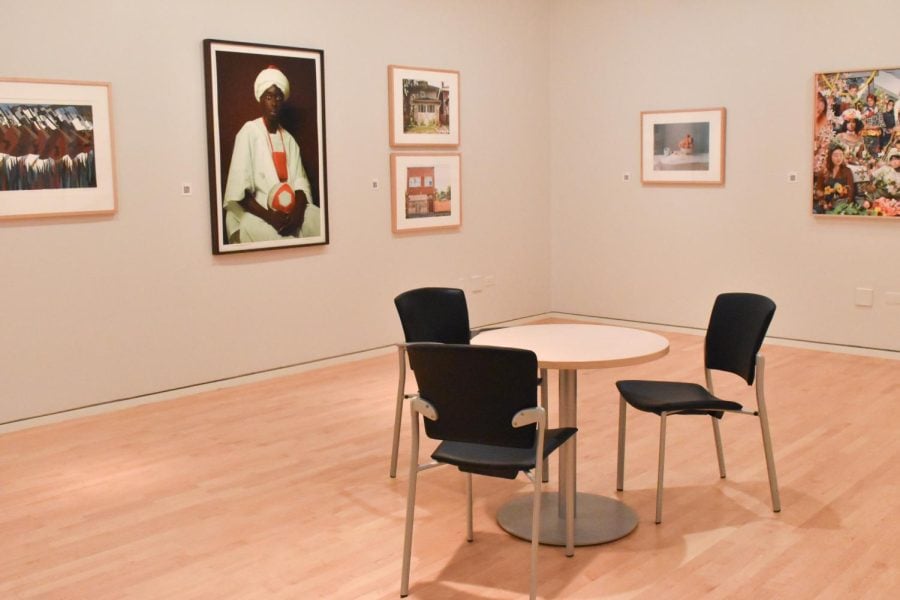The Block Museum’s ‘Looking 101’ exhibit helps visitors practice analyzing artwork
Jessica Ma/The Daily Northwestern
The Block Museum’s “Looking 101” exhibit runs from Sept. 22 to Dec. 4 and encourages close looking.
September 29, 2022
In the Block Museum’s Katz Gallery, visitors are encircled by a collection of images: a bowl of peaches, a math equation, the moon and more. The artworks don’t have accompanying text, allowing viewers to form their own interpretations.
The “Looking 101” exhibit, which runs from Sept. 22 to Dec. 4, provides an exercise in close looking and prompts discussion. The exhibit seeks to support academic instruction, particularly for first-year curriculum.
Essi Rönkkö, the associate curator of collections at the Block, said the artwork’s lack of labels is atypical. According to her, the format allows visitors to first engage with the artwork themselves. “Looking 101” helps people practice basic skills that develop from the slow, analytical process found in research, Rönkkö said.
“Start with looking. Only then, dig into the research and the context,” Rönkkö said. “It really changes how you see things when you give people who made it, what it is, how it’s made.”
Instead of labels, artworks have QR codes posted next to them. When scanned, the codes direct visitors to more information about the piece, including its title and artist. The information is also available in brochures and online.
Lindsay Bosch, the Block’s associate director of communications, marketing and digital strategy, said everyone brings expertise when analyzing artworks, not just art historians.
“Everyone is an expert in their own life and their own experience,” Bosch said. “What you see in (a work), what you say it means — it has weight.”
Rönkkö said she found inspiration in the museum’s study center, where NU courses discuss artworks in a private setting and wanted to create a similar space for general audiences.
Eight faculty members, including Weinberg College Advisor and biology Prof. Marcelo Vinces, worked alongside Rönkkö to select the artworks.
Human emotions sometimes help and other times hinder science, Vinces said. His first-year seminar on biology and society explores how racism, sexism and classism influence science and medicine — which he said are supposed to be objective endeavors. Vinces said he plans to take his students to the exhibit later in the quarter.
As part of the collection, the photograph “Now (Slave Plantation, St. John, Virgin Islands), 09-01” documents a former sugar plantation on St. John, U.S. Virgin Islands. Artist Alan Cohen took the photograph while traveling to sites of historical trauma.
“There’s things in the image itself that students can make commentary on, (as well as) the title and the location,” Vinces said. “(The work) connects directly to some of our readings later in the quarter.”
Leonard Suryajaya’s photograph “Perennial Blossom” from the series “Parting Gift” features 13 Block Museum Student Associates, one Block staff member and Suryajaya’s sister and mother. The photograph was taken outside the Block.
Surrounded by bursts of colorful flowers, Weinberg senior Katy Kim, BMSA programs and tours coordinator, is noticeable in the corner, looking off in the distance.
Kim said BMSA has been a formative part of her NU experience. She said she felt immense pride when she saw the photograph.
The gallery doesn’t center around a theme or historical time period, Kim said, but a practice of looking.
“If we think about the museum as promoting accessibility, you don’t need an immense amount of art history knowledge to understand an artwork.” Kim said. “Anyone can enter the gallery and look. That’s super exciting to me and validating.”
Email: [email protected]
Twitter: @JessicaMa2025
Related Stories:
— Q&A: Artist L.P. Lundy reflects on his career through retrospective Wave After Wave exhibit
— Makeba Kedem-DuBose’s colorful works explore race and gender at Evanston Art Center
— Dittmar Gallery’s “Wordless Creatures” allows artists to represent their identities through objects


